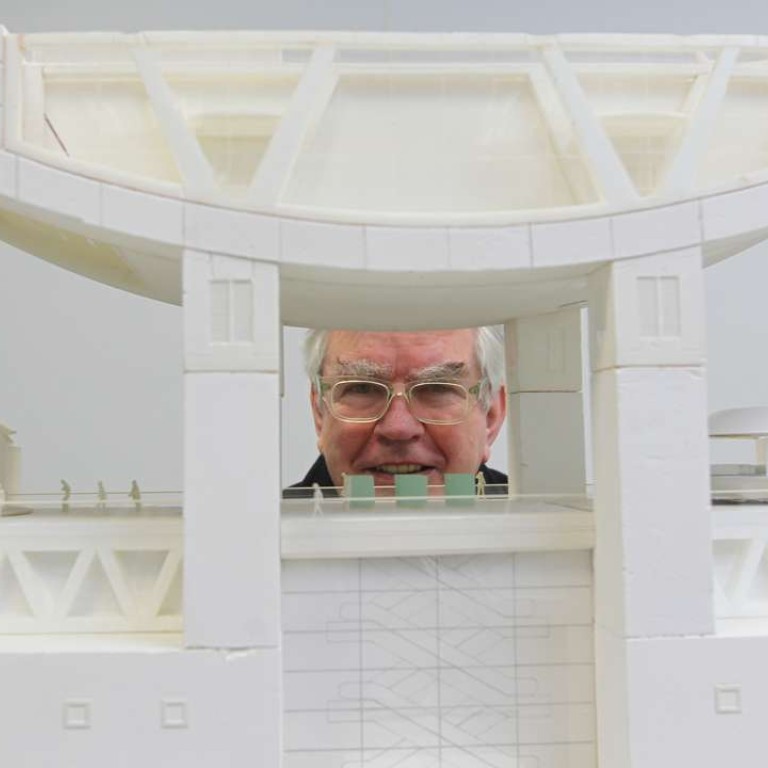
Architect Terry Farrell’s fascination with Hong Kong endures
Briton, whose firm designed city buildings including the Peak Tower, Kowloon Station and British consulate, loves streets where the people and traffic create a buzz. His ideas are on display in two exhibitions this month
Terry Farrell isn’t just an architect – he’s a planner. “You plan the place, not just the buildings,” says the 77-year-old British designer, whose firm, TFP Farrells, is known as much for his advocacy of placemaking as it is for postmodern landmarks like London’s MI6 Building and the Peak Tower in Hong Kong.
“The process you adapt is as important as the product,” he says. “It’s about planning and forethought rather than just the design of icons.”
This month, that philosophy is featured in Urban Dialogue, a pair of exhibitions at the Fringe Club and Peak Tower. Along with highlighting Farrells’ architectural contribution to Hong Kong, the exhibitions will include workshops, forums and lectures that explore the issues at the heart of Farrells’ work, like public space, development oriented around public transport and the sensitive redevelopment of existing neighbourhoods.
Though Farrell founded his firm in London, its Hong Kong office is just as big – an indication of just how important the city is to the architect, who was born to a working-class family in Manchester. He first visited Hong Kong in 1964 to spend time with an old college friend, playboy tycoon Cecil Chao Sze-tsung.
In good streets, the streets in Paris, New York, London and the good bits of Hong Kong, you feel a buzz when there is traffic and people together
Farrell was fascinated by the city, so when he launched his architectural practice in 1980, one of the first international competitions he entered was for a Hongkong Land development. He lost, but made up for it in 1991 by winning bids for the second-generation Peak Tower, the British consulate and the Kowloon Station complex. “We won three competitions inside 12 months,” says Farrell. “We never backed off it. We kept growing.”
Kowloon Station was by far the biggest of those projects, comprising not only an MTR and Airport Express station, but an enormous city-within-a-city that would eventually become home to 35,000 people and Hong Kong’s tallest building, the International Commerce Centre (which was designed by another firm, Kohn Pedersen Fox). “It still is the most complicated thing we’ve ever done,” he says.
Farrell and his team were initially told by the MTR that they couldn’t change the layout of the station, but they successfully convinced the rail operator to build a single grand station hall instead of the discrete entrances common in older MTR stations like Central – “I call them mouseholes,” says Farrell. A large pedestrian-only plaza was designed just outside the station’s main entrance, on the podium deck that served as a new ground level for all of the area’s buildings. “I think people like to go to a station where they can orientate yourself.”
There were compromises, though. Government planners insisted on completely separating vehicular and foot traffic, which created a ground level dominated by access ramps and roadways, while pedestrians are relegated to the Elements shopping mall and the podium deck. “I have reservations about its lack of integration with the urban scene around it, but that had all been predetermined and we couldn’t unravel any aspect of that,” says Farrell.
Farrells principal Stefan Krummeck says the mentality that led to those restrictions is slowly starting to shift. “[People] are realising a sterile groundscape is not so good,” he says.
Farrell adds: “In good streets, the streets in Paris, New York, London and the good bits of Hong Kong, you feel a buzz when there is traffic and people together.”
Farrell invests that attitude even in his skyscraper projects. Before working on the 442-metre Kingkey 100 tower in Shenzhen, which was completed in 2011, Farrell had never done much work with high-rises, and he says he still prefers low- and medium-rise buildings. But when it does tackle towers – TFP Farrells is working on several in mainland China – the firm makes a point of integrating them into the city as best they can. “Very few of our towers are standalone,” says Krummeck. “It’s really about creating new neighbourhoods.”
Farrell says one of his favourite projects is New York’s Rockefeller Center, a 1930s mixed-use development that blends high-rises with public plazas, shopping arcades and an underground shopping mall – an Art Deco precursor to the kind of planning and architecture that is now common in Asian cities.
In 2013, Farrell conducted a survey of the United Kingdom’s built environment, leading to a number of recommendations including an “urban room” – a place where citizens can learn about and discuss urban change. “It’s applicable almost everywhere,” he says. That’s what he and his firm hope to achieve with the upcoming exhibition. “We want people to think about how they can make their experience of the urban environment better,” says Krummeck.
Urban Dialogue will take place from April 15 to 30 at the Fringe Club and Peak Tower. For more information, visit farrells.com/news.

